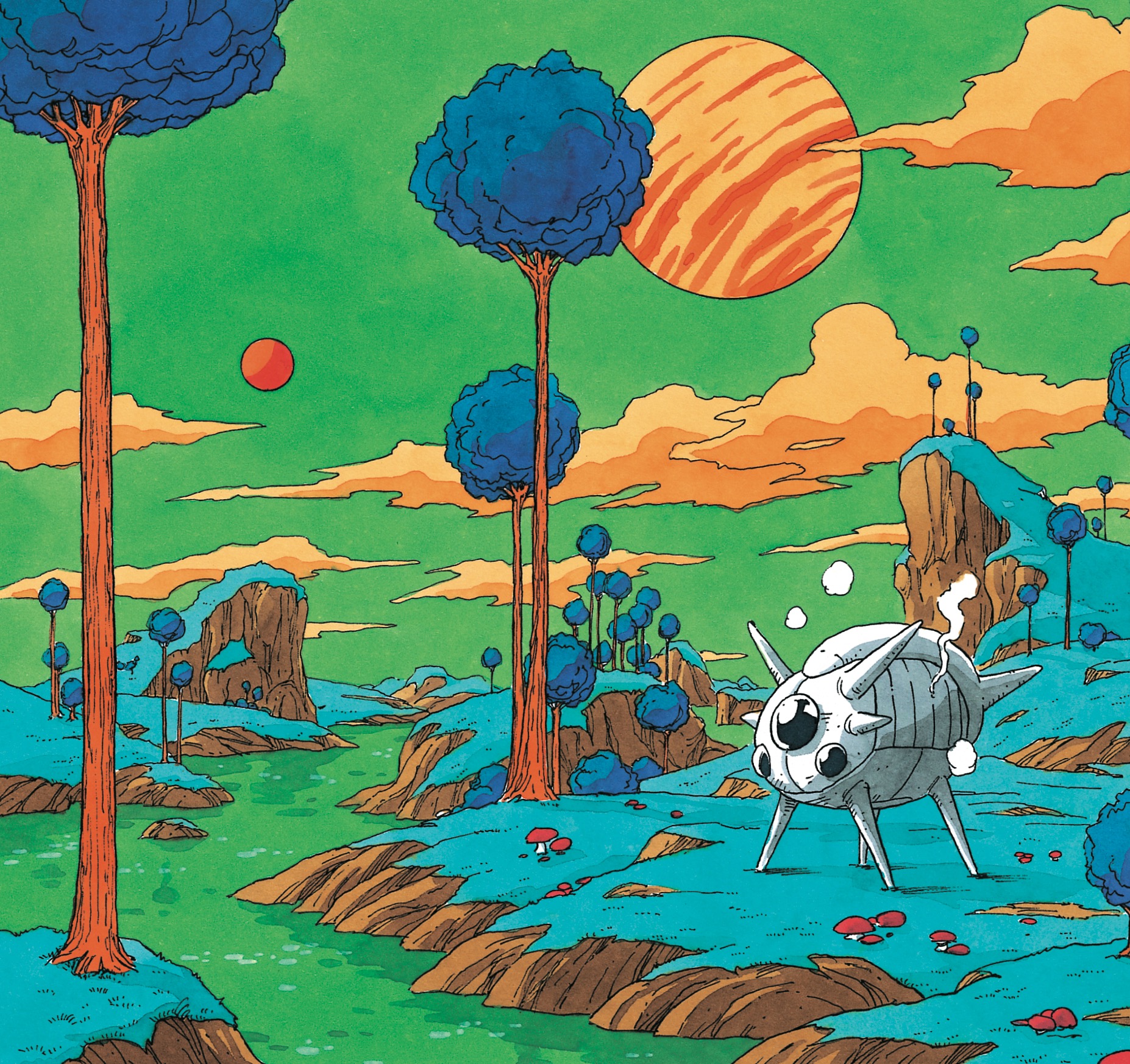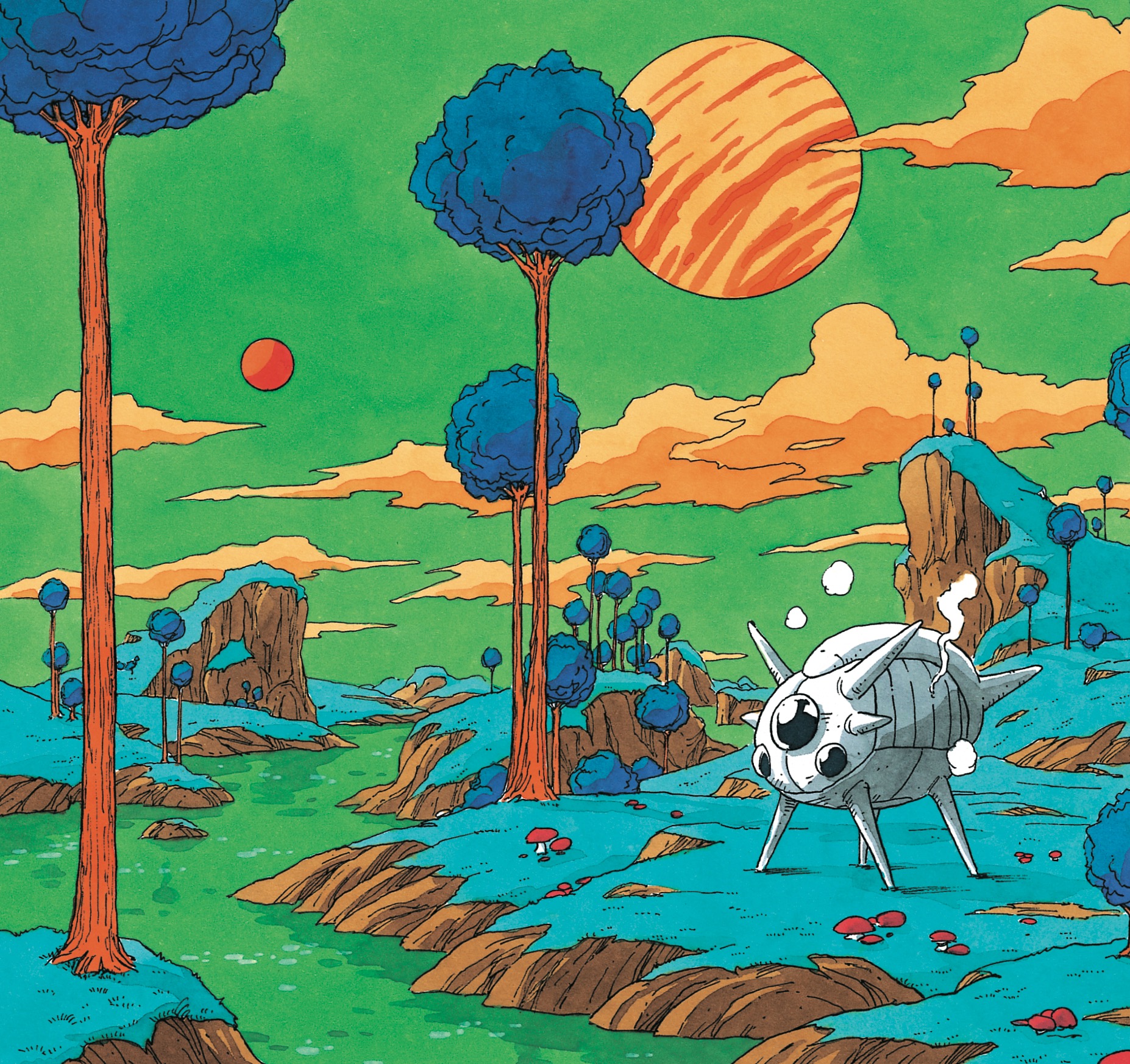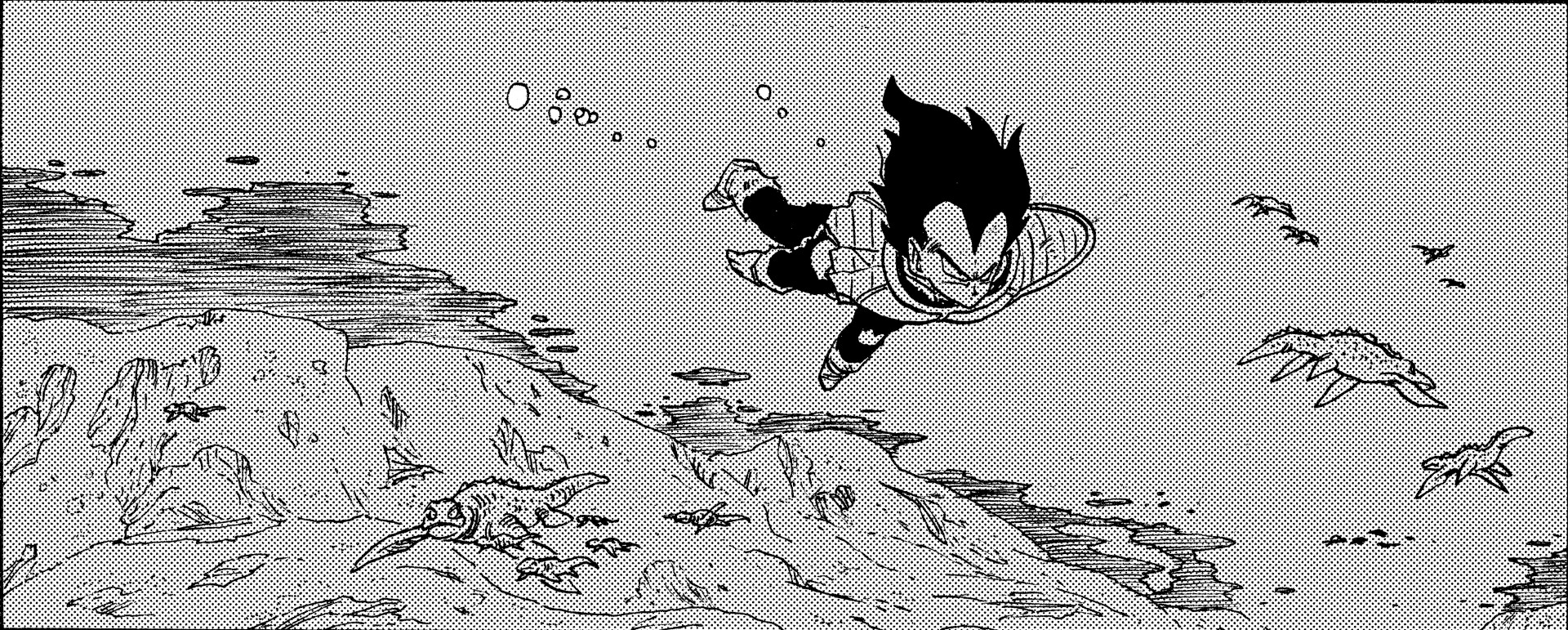NEWS
13.07.2023
Could Humans Survive on Planet Namek? We Asked an Expert to Tell Us About the Planet's Ecosystem

Bulma, Gohan, and Krillin ventured far out into space to Planet Namek in search of the Dragon Balls. Once there, they encountered a stark landscape unlike anything on Earth, complete with tall, alien trees and covered in green bodies of water.
Planet Namek played a big role in the original story of Dragon Ball, but it makes us wonder: just what kind of world is it, really?
We are joined this time by Yasuhito Sekine, a professor at the Tokyo Institute of Technology and someone well-versed in Dragon Ball lore. Professor Sekine will help us to shed some light on this mysterious planet through the lens of planetary science.
Profiles
Interviewee: Professor Yasuhito Sekine
Born in Tokyo in 1978. Director of Tokyo Institute of Technology's Earth-Life Science Institute. Specializes in the field of planetary science. Currently conducts research about the origins of life by investigating how Earth and other planets came to be.

Interviewer: Maishiro
Entertainment analyst. Author of many articles based on serious research (including data analysis and interviews) into non-serious subjects. Articles often featured on Yahoo's freelance page and the Daily Portal Z website. Has a particular fondness for music, films, and manga!
https://twitter.com/_maishilo_
https://note.com/maishilo
https://news.yahoo.co.jp/byline/maishilo
Contents
—First things first: Just what kind type of celestial body is Namek?
Sekine: So, in the universe, we have "stars" like our sun that shine using their own energy source. Then we have "planets" like Earth that revolve around these stars, and "satellites" like our moon that revolve around the planets.
So by those definitions, Namek would be classified as a planet.
—Planet Namek has three suns, but is that kind of thing possible...?
Sekine: Oh, it is totally plausible. Planetary systems with multiple suns pop up fairly frequently, actually.
—Oh, so there are worlds like Planet Namek out there! Because of all those suns it never gets dark on Planet Namek, but is that part realistic, too?
Sekine: Oh, that aspect is a bit far-fetched on a physical level. In systems with more than one sun, the smaller suns always orbit the largest sun.
Furthermore, the planets in that system would then orbit the suns, so no matter how many suns there are, the planets would still experience night at some point.

▲Three suns in orbit around Planet Namek.

▲The 2nd largest of the suns orbits the largest sun, and the smallest of the 3 suns orbits the 2nd largest one. Finally, the planet(s) orbit those suns.
—In other words, Planet Namek's environment must be quite strange! But looking at just the surface, it seems to resemble Earth in a lot of ways.

Sekine: Oh, their landscapes ARE really similar. And since Gohan, Krillin, and the others were able to walk normally on its surface, the gravity on the planet must be about the same as Earth's, too.
Having the same gravitational pull means that the masses of the planets must be about the same.
Planets that orbit stars other than the sun are called "exoplanets". But the exoplanets that have been discovered so far are usually larger than Earth with several times the density and gravitational pull of Earth. Exoplanets with masses several time larger than Earth's are called "Super-Earths", which makes it sound like something you'd find in Dragon Ball actually, kind of like a Super Saiyan.
If we get right down to it, planets the size of ours are rather unimpressive, so it'd be fair to say that Planet Namek is kind of like Earth's big brother since they're so similar.
—To look at it another way, does Planet Namek have any differences from our planet?
Sekine: Well the three suns are a big one, and all that light would mean that the seasons would have much less variation than the ones on our planet.
I'd also say that Planet Namek probably has less water than Earth does. I can see that it has many lakes, but they look shallow and not deep like the oceans we have here.
And if we're talking about the environment on the surface, it seems to resemble Saturn's largest moon, Titan.
Liquid methane can be found on the surface of Titan, but the amount doesn't come close to the amount of liquid contained in Earth's oceans. Titan's equator is loaded with deserts, and conditions get damper the closer you get to its north and south poles, so the number of lakes grow. That's why I think that the surface of Planet Namek is close to that of Titan.
—You were able to extrapolate so much about the planet from just those small details! That's absolutely fascinating!
—Planet Namek has a distinctly green sky. Is this kind of thing possible?

Sekine: I've actually given this a lot of thought. (Laughs) It's really tricky, but I have one tentative theory.
For starters, the reason why Earth's sky is blue is because of the interaction between the atmosphere and various wavelengths of light.
Light actually has waves with differing qualities, and the length of which we refer to as wavelengths. Blue light has a short wavelength, while red light has a long wavelength. Of all the light that comes from the sun, blue light, with its short wavelength, is easily scattered in all directions by atmospheric molecules. That scattered blue light is visible to our eyes, and that's why the sky looks blue to us.
On the other hand, sunsets appear reddish to our eyes.
When the Sun dips below the horizon, light has to travel a long distance through the atmosphere before we are able to see it, and as a result the blue light gets completely dispersed because of its short wavelength. So why do sunsets look red? Well, red light actually has the longest wavelength, so that means that this type of light remains and gets scattered the least.
Moving on, the green light we see on Planet Namek has a wavelength halfway between that of red and blue light, which would make it hard for it to become the dominant color. That makes me think that the green sky on the planet probably did not come about by natural means.
—In that case, just what is the cause for Planet Namek's green-hued skies?
Sekine: I think there must be green colored microorganisms living in the clouds there.
—So you mean there are some mysterious, extraterrestrial lifeforms on the planet that give its skies their iconic green color.
Sekine: Yes, I think would be the most likely reason. And since more sunlight would reach there than on the surface of the planet, it would be a convenient place for organisms that use photosynthesis to live.
So, in the end, I think that Planet Namek's green skies are all thanks to those mysterious microorganisms in the clouds, and not due to any climate or atmospheric cause.
—What a fascinating discussion this has turned out to be! When I think about wildlife on Planet Namek, my impression is that the majority of these creatures live in the water. Is a planet filled with aquatic life possible in the real world?


Sekine: Life on Earth originally began and evolved in the ocean, so I think it's completely possible. Around 500 to 600 million years ago there was no life on Earth’s surface, so all life was aquatic at that point in time.
Water actually supports life very well, as it provides its inhabitants with a certain layer of protection from interstellar ultraviolet rays and climate changes.
So, it might just be that life on Planet Namek resembles what existed on Earth several hundreds of millions of years ago, and it could evolve into land-based creatures as time goes on.
—That really makes you want to see what happens on Planet Namek far in the future!
—Much to Bulma's dismay, Gohan and Krillin rushed to step out onto Planet Namek's surface as soon as they arrived on the alien world.

Sekine: Yes, what they did is extremely dangerous.
Even for planets in our own solar system, decades of research and preparation would be required before anyone or anything could step foot onto the surface of another planet.
—Decades?! That really changes things!
Sekine: We use the term "Flyby" to refer to a space exploration mission where a probe is sent near a planet or celestial body to take pictures of its surface conditions.
Following a flyby, the thrust of the rocket engines is reversed to put the probe in a trajectory where it will orbit said body to carry out an orbital survey. This allows the probe to collect detailed information about the atmosphere and terrain there.
Setting foot on a planet would only happen after all that has been completed, but even then it wouldn't be an astronaut doing it. Instead, an unmanned spacecraft would be sent out first.
These kinds of surveys are carried out before a human being can step in directly. After all, there's always the possibility that there are unknown viruses or lifeforms waiting there. Plus, there's also the risk of bringing viruses and microorganisms with us from Earth.
—So in Planet Namek's case, there should have been surveys and at least two spacecraft sent in advance before Krillin and Gohan stepped out onto the terrain...

Sekine: Yep, Bulma had it all right. (Laughs) Even when carrying out a manned expedition you would confirm the conditions outside before you left your spacecraft, so the scene where Bulma is going through the final check is very realistic.
Even so, I wish that Bulma had done her check of the atmosphere with a proper orbital survey first. (Laughs)
—All three of them do seem a bit impatient in that regard. After that, they are able to survive in Planet Namek's environment, but could a normal human do the same?
Sekine: Well, since there's water and the gravity there is about the same as Earth's, I'd say that a human could at least take a short trip there and be fine.
However, trying to live there is another story. You'd have to develop an agricultural system to ensure that there would be food for you to eat, and Planet Namek's relative lack of water would make doing that on a large scale difficult.
Also, bacteria and microorganisms are absolutely essential for farming, so you'd either have to bring them with you from Earth or confirm that they exist on Planet Namek in advance.
—We've discussed all about Planet Namek thus far, but I'd like to change the topic for our last question today. What is the current state of space exploration in the real world?
Sekine: There are projects currently underway to prepare our species to move to another planet.
One of the most famous of these is the Artemis Program headed by NASA, in which Japan also participates. Some of the goals of this project are to study how much water exists on the Moon and to ultimately build living quarters there.
After the Moon, Mars is an excellent candidate for exploration and colonization. There's an abundance of ice below Mars' surface, so that should make it easier than the moon for humans to live there. The challenge, of course, is how far away it is.
So, if everything goes smoothly, it is possible that we'll have people living on both the Moon and Mars by around the year 2050.
—So we might just see humans living on other planets in the near future! Thank you so much for agreeing to do this interview with us today!
This site includes machine-translated texts. Please be aware that you might find some unusual expressions that are difficult to understand.
Post
Confirm Post
Post the above comment?
Reply
Confirm Reply
Post the above comment?
Are you sure you want to delete this comment?
Report successful
Post Unsuccessful
This user will be muted.
You will be unable to see comments from muted users in the comments area.
*To unmute users, navigate to the "Comments" area on MY PAGE.
Reply
Confirm Reply
Post the above comment?
Edit
Post


Post
Confirm Post
Post the above comment?
Edit
Post